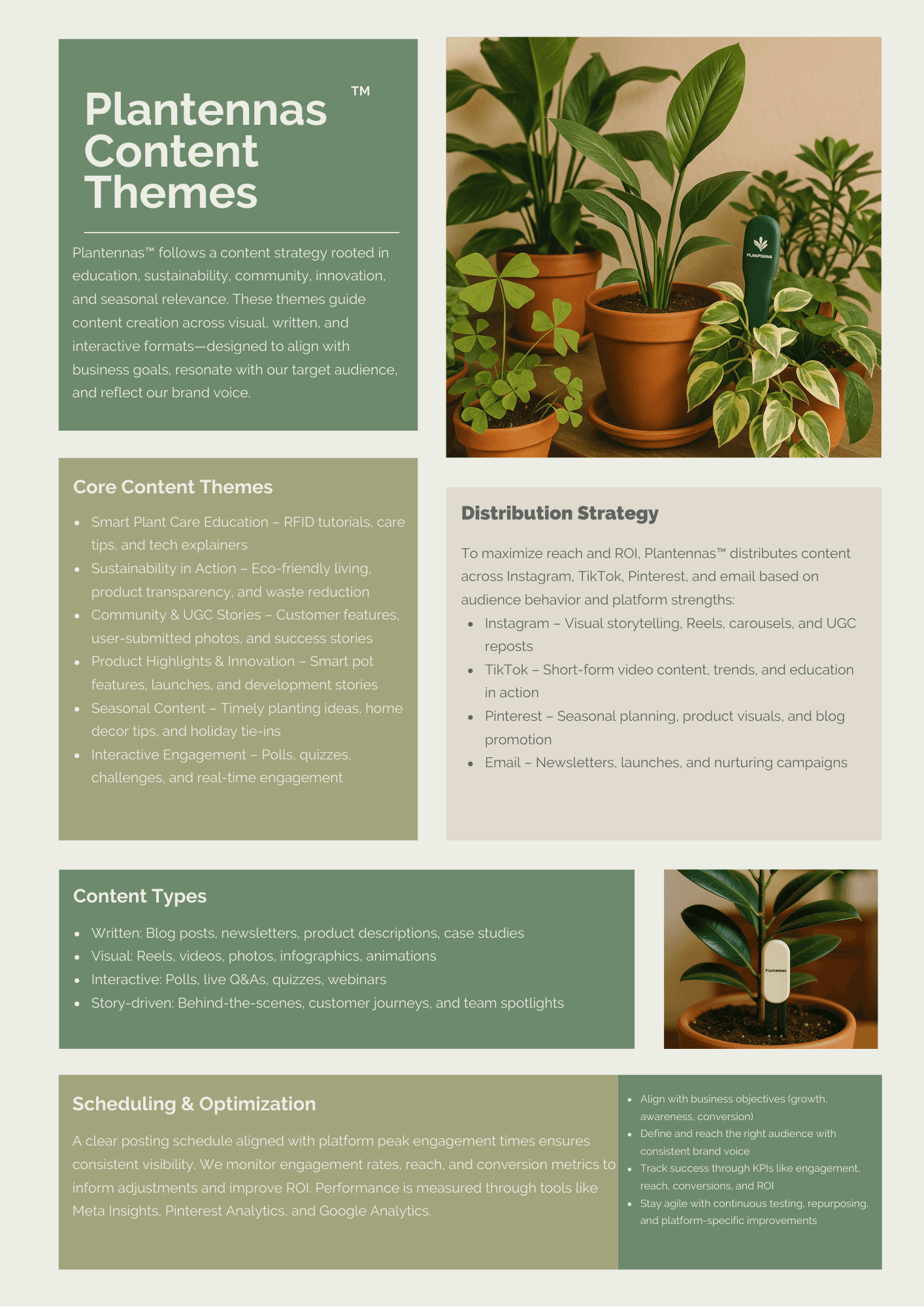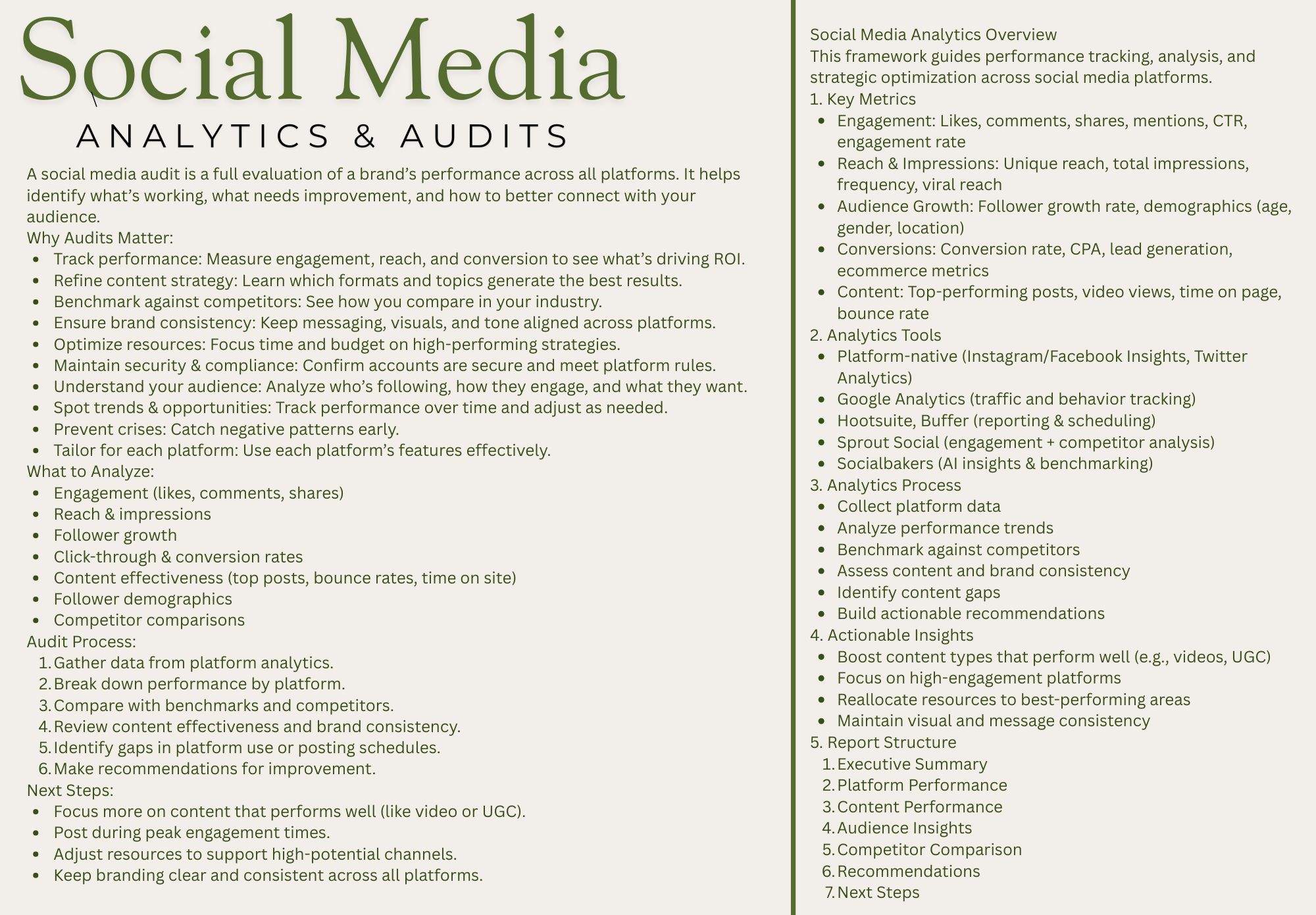Platform Selection
Selecting the right social media platforms for marketing success means aligning your audience, content type, and goals with each platform’s strengths. Instagram and TikTok are ideal for Plantennas™ due to their visual focus and high engagement with younger, eco-conscious users. Pinterest supports product discovery and seasonal content, while LinkedIn offers a space for thought leadership around smart tech and sustainability. Focusing on these key platforms allows efficient content creation, stronger audience targeting, and better ROI, rather than spreading resources across less relevant channels.
Content Themes and Guidelines
Engagement Strategy
Community-First Approach
Focus on building an inclusive community of plant lovers through regular interactions. Use user-generated content (UGC) campaigns to encourage followers to share their plant setups using #PlantedWithPlantennas.
Interactive Weekly Content
Post weekly engagement-driven content like polls (e.g., “How often do you water your plants?”), quizzes (e.g., “Which plant matches your personality?”), and caption contests.
Consistent Reply Routine
Respond to comments and DMs within 24 hours to foster trust and loyalty. Like and comment on tagged user photos to strengthen relationships.
Influencer & Micro-Partnering
Collaborate with plant influencers and micro-creators to co-host giveaways, challenges, or takeover stories to drive organic engagement.
Live & Real-Time Engagement
Host monthly Instagram Lives for Q&A sessions, repotting demos, and seasonal plant care advice. Use countdown stickers and engagement stickers in Stories to boost visibility.
Saveable + Shareable Posts
Prioritize content formats that spark shares (infographics, plant care tips) and saves (step-by-step guides, seasonal care checklists).
Data-Driven Adjustments
Use Instagram Insights, TikTok Analytics, and email engagement reports to refine what content and timing generate the highest interactions.
Posting Schedule
Strategy & Structure
Aligns with campaigns, product launches, and seasonal events
Outlines publishing frequency and peak posting times
Includes flexibility for trending or real-time content
Differentiates content by platform (e.g., Instagram visuals vs. LinkedIn insights)
Content Planning & Categories
Balanced mix of content types: educational, promotional, UGC, and engagement
Content mapped by format: posts, videos, stories, carousels
Platform-exclusive vs. cross-posted content clearly labeled
Built around core content pillars and brand voice
Workflow & Collaboration
Tracks content status: planning, review, approved, published
Assigns team roles and deadlines
Includes review checkpoints for legal/compliance
Houses asset links (copy, images, videos) for easy access
Monitoring & Performance
Tracks key performance metrics per post (reach, clicks, engagement)
Schedules engagement times to respond to comments/messages
Uses analytics to guide content adjustments
Helps teams identify repurposing opportunities and gaps
Community Management Plan
Engagement Protocols
Daily Monitoring: Check DMs, comments, and mentions 2–3 times per day
Response Time: Reply to questions and comments within 12–24 hours
Tone of Voice: Friendly, supportive, plant-savvy — consistent across platforms
Engagement Tactics: Use polls, questions, and interactive stickers in Stories to boost engagement
Community Building
User Highlights: Repost user-generated content weekly with credit
Live Interactions: Host monthly Instagram Lives for plant care demos or Q&A sessions
Discussion Threads: Use comment prompts to spark dialogue (e.g., “What’s your favorite indoor plant?”)
Contests & Giveaways: Run community campaigns to grow reach and reward loyal followers
Moderation & Issue Management
Community Guidelines: No hate speech, spam, or off-topic content
Escalation Protocol: Flag and privately address conflicts or negative feedback quickly
Crisis Response: Pre-approved message templates for common complaints or concerns
Recognition & Loyalty
Top Commenter Shoutouts: Monthly recognition posts for highly engaged followers
Feature Fridays: Showcase a customer story, plant setup, or testimonial
Birthday/Anniversary DMs: Personalized messages for high-engagement followers

